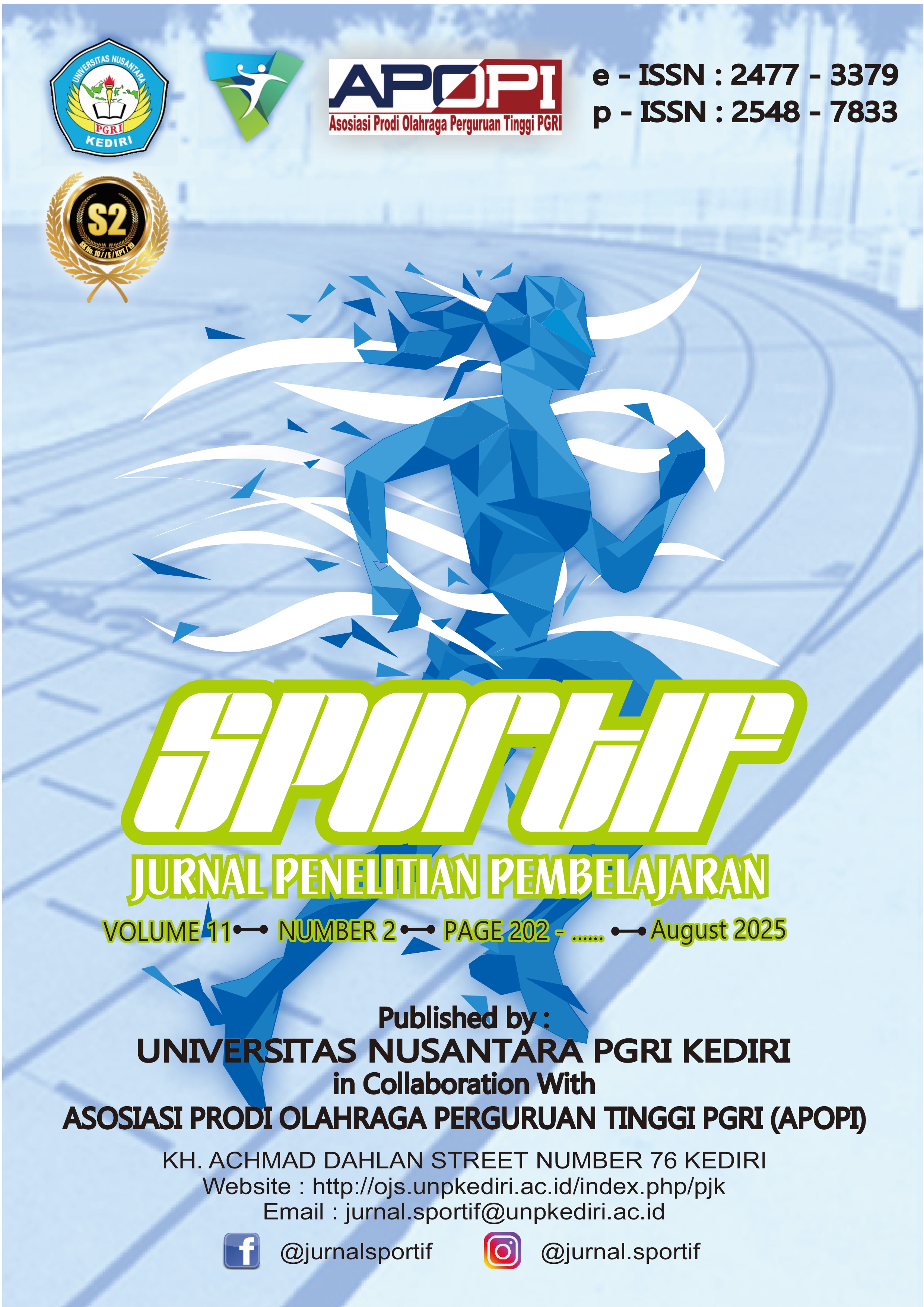Abstract
Student engagement in physical education is essential for promoting active participation and effective learning. However, traditional teaching methods often struggle to maintain students’ interest and motivation. In response to technological advancements, this study explores how e-module development, teacher creativity, and technology use affect student engagement in sports education, with technology acting as a moderating variable. A quantitative approach was applied, involving 150 Indonesian high school students selected through purposive sampling, focusing on those actively participating in physical education and using e-modules. Data were collected via structured questionnaires measuring e-module development, teacher creativity, technology use, and student engagement. The data were analyzed using Partial Least Squares (PLS) 4.0. The results show that e-modules (β = 0.420, t = 7.746, p < 0.001), teacher creativity (β = 0.212, t = 3.668, p < 0.001), and technology (β = 0.200, t = 4.392, p < 0.001) significantly enhance student engagement. Moreover, technology strengthens the influence of both e-modules (β = 0.303, t = 5.908, p < 0.001) and teacher creativity (β = 0.214, t = 3.783, p < 0.001) on student engagement. These findings underscore the importance of integrating digital tools and creative teaching strategies in physical education. The study provides practical implications for educators aiming to boost student involvement through innovative, technology-supported instruction.
References
Abbad, M. M. M. (2021). Using the UTAUT model to understand students’ usage of e-learning systems in developing countries. Education and Information Technologies, 26(6), 7205–7224. https://doi.org/10.1007/s10639-021-10573-5
Brunsdon, J. J. (2022). Toward the virtuous mover: a neo-Aristotelian interpretation of physical education. Physical Education and Sport Pedagogy. https://doi.org/10.1080/17408989.2022.2135693
Brunsdon, J. J. (2023). ‘it’s about bringing people together’: one middle school physical education teacher’s attempt at deploying character education. Physical Education and Sport Pedagogy. https://doi.org/10.1080/17408989.2023.2256753
Castro, J., & Morgan, K. (2025). Critical application of TGfU in sports coaching. In Physical Education and Sport Pedagogy (pp. 1–15). Informa UK Limited. https://doi.org/10.1080/17408989.2024.2446780
Coote-Thompson, C. (2023). Balancing Sport Prowess with Sport Education in the Caribbean. In Canada International Conference on Education (CICE-2023) and World Congress on Education (WCE-2023) (p. 23). Infonomics Society. https://doi.org/10.20533/cice.2023.0003
Fernandez-Rio, J., & Casey, A. (2020). Sport education as a cooperative learning endeavour. In Physical Education and Sport Pedagogy (Vol. 26, Issue 4, pp. 375–387). Informa UK Limited. https://doi.org/10.1080/17408989.2020.1810220
Goodyear, V. A. (2024). Digital Natives in Sport Education. In Digital Natives in Sport Education. Routledge. https://doi.org/10.4324/9780367766924-ress98-1
Hananingsih, W., & Imran, A. (2020). Modul Berbasis Pendekatan Saintifik Dalam Pembelajaran Pendidikan Jasmani Olahraga Dan Kesehatan. JUPE: Jurnal Pendidikan …. https://ejournal.mandalanursa.org/index.php/JUPE/article/view/1593
Kerner, C., & Prescott, A. (2023). Body Image in Sport Education. In Body Image in Sport Education. Routledge. https://doi.org/10.4324/9780367766924-ress62-1
Miller, J., Pierce, D., Johnson, J., & Stokowski, S. (2023). Undergraduate sport management curricula in the United States: A content analysis. In Journal of Hospitality, Leisure, Sport & Tourism Education (Vol. 33, p. 100457). Elsevier BV. https://doi.org/10.1016/j.jhlste.2023.100457
Pranata, S. P. (2024). Digital Literacy, Skills, and Security: Impact on Digital Leadership in Higher Education. Al-Tanzim: Jurnal Manajemen Pendidikan Islam, 8(3), 775–791. https://doi.org/10.33650/al-tanzim.v8i3.8538
Robitzsch, A. (2020). Why Ordinal Variables Can (Almost) Always Be Treated as Continuous Variables: Clarifying Assumptions of Robust Continuous and Ordinal Factor Analysis Estimation Methods. Frontiers in Education, 5. https://doi.org/10.3389/feduc.2020.589965
Saputra, R., & Barikah, A. (2021). Spiritual Dengan Prestasi Belajar Pendidikan Jasmani. UPT Publikasi Dan Pengelolaan Jurnal Universtas Islam Kalimantan Muhammad Arsyad, 4(1), 60–68. http://dx.doi.org/10.31602/rjpo.v4i1.4985
Vavenkov, M. V. (2022). VR/AR technologies and staff training for mining industry. Mining Science and Technology (Russian Federation), 7(2), 180–187. https://doi.org/10.17073/2500-0632-2022-2-180-187
Wallhead, T. L., Hastie, P. A., Harvey, S., & Pill, S. (2020). Academics’ perspectives on the future of sport education. In Physical Education and Sport Pedagogy (Vol. 26, Issue 5, pp. 533–548). Informa UK Limited. https://doi.org/10.1080/17408989.2020.1823960
Waqas, A. (2022). Predicting Remission among Perinatal Women with Depression in Rural Pakistan: A Prognostic Model for Task-Shared Interventions in Primary Care Settings. Journal of Personalized Medicine, 12(7). https://doi.org/10.3390/jpm12071046
Wei, H. C. (2020). Online learning performance and satisfaction: do perceptions and readiness matter? Distance Education, 41(1), 48–69. https://doi.org/10.1080/01587919.2020.1724768

This work is licensed under a Creative Commons Attribution-ShareAlike 4.0 International License.
Copyright (c) 2025 Frendy Aru Fantiro, Abdurrohman Muzakki, Bayu Budi Prakoso, Setiya Yunus Saputra, Adelya Dwi Cendani Putri






